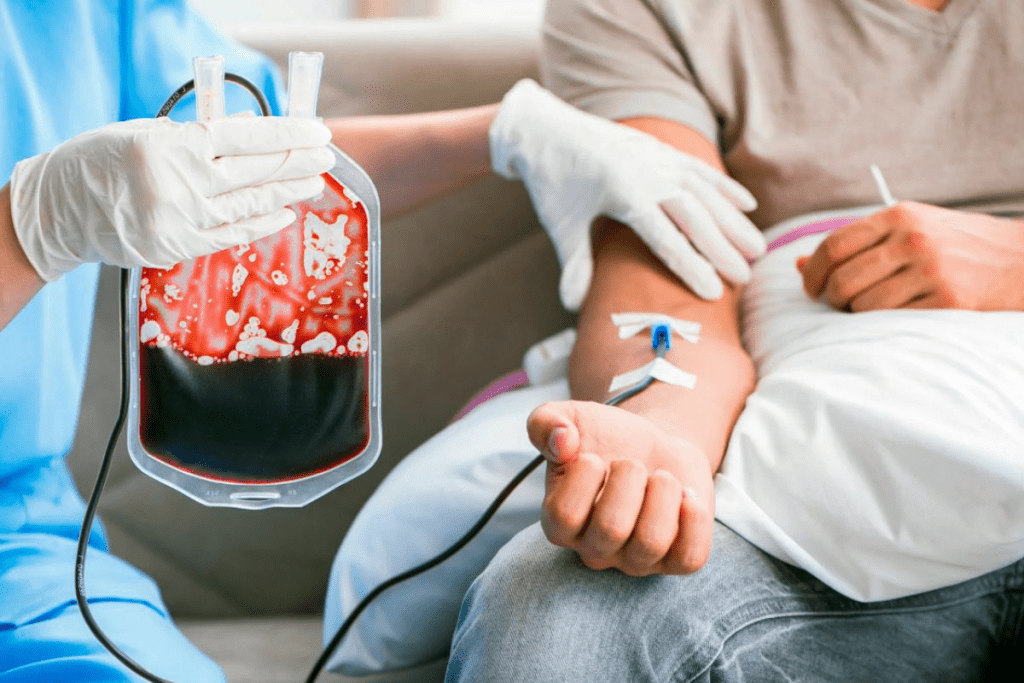Last Updated on November 14, 2025 by

When kids show signs like constant bruising, tiredness, or strange fevers, doctors might send them to a hematologist. A hematologist is a medical specialist who diagnoses and treats blood-related disorders. Kids often go to hematology for checking and treating different blood problems.Learn what does a hematologist do when a child is referred for blood-related conditions. Understand the referral process and common reasons.
At Liv Hospital, we know how important it is to send kids to hematology quickly. Our team of experts works hard to give kids the best care for their health issues.

Pediatric hematology is key to tackling blood issues in kids. It’s a branch of medicine focused on diagnosing, treating, and managing blood disorders in children. These can be simple, like anemia or complex, like leukemia.
Pediatric hematologists are experts in treating blood disorders in kids. They’ve had a lot of training to understand how blood diseases affect children differently than adults. They know a lot about how kids’ bodies grow and change, making it a very specialized field.
Blood disorders in kids can really affect their life quality. So, pediatric hematologists work with families to give kids the best care. This care helps not just the medical issue but also the child’s overall health and happiness.
Hematology is about blood disorders, but adult and pediatric hematology are different. Kids’ bodies are growing and changing, which affects how they react to treatments. For example, kids’ metabolisms and how they process drugs are different from those of adults, needing special treatment plans.
Also, pediatric hematology deals with blood disorders that kids are born with or develop during childhood. These need a special approach that takes into account the child’s growth and development.

Some blood disorders in kids need a hematologist’s help. Hematologists are experts in blood and its parts. They deal with bleeding disorders that can really affect a child’s life.
Bleeding disorders mess up blood clotting. Normal blood clotting is a complex process. Kids with these disorders can’t clot properly, leading to too much bleeding.
There are many bleeding disorders, like Hemophilia A and B, and Von Willebrand Disease. Symptoms include easy bruising, frequent nosebleeds, and long bleeding after injuries or surgeries.
To diagnose, doctors look at the child’s medical history and do tests. Laboratory tests like clotting factor assays help find the exact disorder.
Treatment depends on the disorder and the child’s health. Treatment options might include replacing clotting factors or using medicines to help with clotting.
It’s important for parents and caregivers to know about bleeding disorders. Spotting signs early means kids can get the right help from hematologists.
A pediatric hematologist is key in diagnosing and treating blood disorders in kids. They handle a variety of blood issues, like bleeding and clotting problems, and blood cancers.
When a child sees a hematologist, the first step is a detailed check-up. This includes looking at the child’s medical history, doing a physical exam, and running tests. The American Academy of Pediatrics says these specialists can understand these tests and plan the best treatment.
The treatment might be medicine, blood transfusions, or other steps to manage the condition. For example, kids with bleeding disorders might get clotting factor infusions to stop bleeding. It’s important to keep a close eye on these treatments and adjust them as needed.
Pediatric hematologists also help families understand their child’s illness and the healthcare system. This support is vital for families facing a child’s chronic illness. They work with other doctors to make sure kids get all-around care that focuses on their health and happiness.
In short, a pediatric hematologist does a lot more than just treat blood disorders. They offer emotional support and guidance to families. Knowing what a hematologist does helps parents better care for their child and get them the best treatment.
Pediatric hematologists are key in diagnosing and treating blood disorders in kids. When your child sees a hematologist, it can be scary and overwhelming. These doctors specialize in blood-related conditions and are vital for kids because their blood disorders are different.
Hematologists use many tests to find out what’s wrong with your child’s blood. They might do complete blood counts (CBCs), blood smears, bone marrow biopsies, and genetic tests. These help figure out why your child is feeling sick, like anemia or bleeding problems.
The first step is a detailed medical history and physical check-up. Then, based on what they find, they might do more tests. For example, a CBC shows if there are any blood cell issues. A bone marrow biopsy gives a closer look at how blood cells are made.
After finding out what’s wrong, the hematologist creates a treatment plan just for your child. This plan considers your child’s health, how serious the condition is, and the best treatments. It’s a detailed plan to help your child get better.
The plan might include medicine, transfusions, or other treatments. Kids with bleeding disorders might get clotting factor therapy. Those with anemia might need iron supplements. We make sure families understand the plan and offer support and check-ups to adjust it as needed.
Pediatric hematologists use the latest tests and make treatment plans that fit each child. Our aim is to help kids with blood disorders live better lives. We want them to be healthy and active.
It’s important to know when a child needs specialized care. A hematologist is often called when certain signs point to a blood disorder.
Children might see a hematologist for unexplained bruising, fatigue, or pallor. Also, frequent infections, jaundice, or enlarged lymph nodes are red flags. These signs could mean a blood issue that needs expert attention.
Parents should watch their child’s health closely. If they notice anything odd or persistent, they should get medical help right away.
Labs are key in spotting blood disorders. Low blood counts, abnormal white blood cell differentials, or clotting disorders might lead to a visit. These could signal anemia, leukemia, or bleeding disorders needing expert care.
Primary care doctors are usually the first to see children with blood issues. They send kids to hematologists if tests show a need for more detailed care. This decision is based on what the doctor finds and thinks.
Seeing a hematologist quickly is key to good treatment. Waiting too long can hurt treatment results. So, doctors should know when to refer, and parents should act fast if they’re worried about their child’s health.
Pediatric hematology-oncology is key in diagnosing and treating blood disorders and cancers in kids. It combines the skills of hematologists and oncologists for full care of young patients.
Leukemia, lymphoma, and neuroblastoma are cancers that need hematology care in kids. These cancers affect the blood and lymph systems. Pediatric hematology departments handle these cases, giving kids and their families the support they need.
Leukemia is a blood cancer that’s the most common in kids. Lymphoma impacts the lymphatic system. Neuroblastoma grows in the nerve tissue of young kids.
The journey to diagnose childhood cancers involves many tests. First, doctors look at physical symptoms and laboratory findings to decide if more tests are needed. If cancer is suspected, a detailed diagnostic process follows, including imaging and genetic tests.
Pediatric hematology-oncology specialists are vital in this process. They help families understand the diagnosis and treatment plan. Their knowledge ensures kids get the right care at the right time, improving their chances of beating cancer.
When your child sees a hematologist for the first time, you might feel unsure. It’s normal to feel a bit anxious. But knowing what to expect can make things easier for everyone.
Getting ready for your child’s first visit is important. Gather all medical records they have. Make a list of questions you want to ask. Explain the visit to your child in simple terms to help them feel better.
On the day of the visit, make sure your child is ready. Bring something they love to keep them calm. Arriving early to fill out paperwork is a good idea.
The hematologist will start with a detailed medical history and physical exam. They will review your child’s medical history and talk about symptoms. They will also do a physical exam to look for signs related to the condition.
Depending on your child’s condition, they might need more tests. These could be blood tests, bone marrow exams, or imaging studies. We will explain each test in detail, including what to expect and how to prepare your child.
After the tests, we will talk about the diagnosis and treatment options. This is your chance to ask questions and understand what’s next for your child’s care.
Being prepared and knowing what to expect can make the experience better for you and your child. Our team is here to provide caring and thorough care, aiming for the best health outcomes for your child.
Dealing with hematology care for kids can be tough for families. Pediatric hematology is a special field that needs a deep understanding of blood issues in children. When a child sees a hematologist, it’s key to know their role and what treatments are used.
We’ve looked at common blood disorders that need a hematologist’s help. We’ve also talked about the signs that lead to a referral and what happens at the first visit. Knowing these things helps families navigate the care system better and get the best care for their child.
As a parent, it’s normal to feel overwhelmed by your child’s health problems. But, working with a pediatric hematologist can make a big difference. We suggest asking lots of questions, seeking support, and staying informed every step of the way.
A pediatric hematologist is a doctor who focuses on blood disorders in kids. They treat conditions like bleeding, anemia, and blood cancers. Their goal is to help children with these issues.
A child might see a hematologist if they have symptoms like easy bruising or frequent infections. Doctors might send them for a closer look and treatment.
Children can have bleeding disorders, anemia, leukemia, lymphoma, and sickle cell disease. These need special care from pediatric hematologists.
At the first visit, the doctor will take a detailed medical history and do a physical check. They’ll also run tests to find out what’s wrong. Then, they’ll make a treatment plan just for the child.
Pediatric hematologists use tests like blood counts and bone marrow biopsies. They also do genetic testing to find out what’s wrong.
Hematologists are key in treating childhood cancer, like leukemia and lymphoma. They work with others to plan treatments like chemotherapy and bone marrow transplants.
Seeing a hematologist doesn’t always mean a serious problem. But, it’s important to go and find out what’s wrong and get the right treatment.
A hematologist deals with blood disorders, while a hematologist-oncologist also treats blood cancers. The oncologist is trained to handle both blood disorders and cancer in kids.
To get your child ready, explain the visit’s purpose and let them ask questions. Bring any medical records or test results to the appointment.
Subscribe to our e-newsletter to stay informed about the latest innovations in the world of health and exclusive offers!